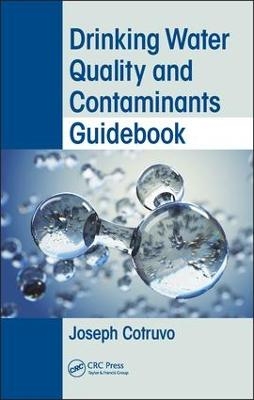
Drinking Water Quality and Contaminants Guidebook
Crc Press Inc (Verlag)
978-0-8153-6305-7 (ISBN)
K347191 BCC
Drinking water quality is a sensitive issue, and the public is constantly barraged by contaminant reports now routinely at parts-per-trillion. Protection from microbial disease risks from drinking water must always be predominant; trace chemicals usually fall farther down the scale of possible health risks, but even negligible detections raise public concerns.
Drinking Water Quality and Contaminants Guidebook presents information and guidance on drinking water quality and regulatory issues reflecting experiences and judgments from the author’s more than 43 years of extensive experience. It contains digested comprehensive information on important chemical, microbial, and radionuclide water contaminants, and discussions of several drinking water-related policy issues. Information is presented for long-standing regulated contaminants and chemicals of emerging concern in understandable terms for professionals and non-experts alike. Dossiers contain readily accessed information on sources, physical and chemical properties, toxicity, analytical methodology, water treatment technology, regulations and health advisories, and also include World Health Organization Guidelines. Aesthetic and acceptance factors such as water hardness and salinity that influence public perceptions of drinking water quality are also addressed.
Features:
Compiles and interprets essential information on numerous key chemical, microbial, and radionuclide water contaminants
Provides standardized entries for each contaminant, including occurrence, health, analytical, water treatment, regulations, and World Health Organization guidance and recommendations with source citations
Examines many water-related topics including fracking, potable water reuse, desalination, boil water notices, bottled water, foodborne and waterborne disease, and public perceptions about public drinking water quality
Provides essential information and the basis for management of many long-standing contaminants such as lead, mercury, disinfection by-products, E. coli, and also emerging issues such as legionella, glyphosate, BPA, and more
Dr. Joseph Cotruvo is president of Joseph Cotruvo and Associates, Water, Environment and Public Health Consultants, in Washington, DC, USA, with a BS in Chemistry from the University of Toledo, and PhD in Physical Organic Chemistry from The Ohio State University. He is Board Certified in Environmental Sciences, and is Research Professor in Chemistry and Environmental Sciences at The University of Toledo, and on the Green Chemistry and Engineering Science Advisory Board. He is a longtime member of the World Health Organization’s Guidelines for Drinking Water Quality Committee, and serves on numerous advisory panels on drinking water quality, and potable water reuse, including Singapore’s NEA Water Standards Advisory Committee, and direct and indirect potable water reuse projects with the National Water Research Institute for Orange County, San Diego, and Los Angeles, California. He is a technical editor for the American Water Works Association Journal, Water Science Journal, and Water Technology online. He has written more than 300 publications, presentations and articles on health risk, water quality and safety, and water regulatory policy. At the US EPA, Dr. Cotruvo was the first Director of the Drinking Water Standards Division, and Director of the Risk Assessment Division in Pollution Prevention and Toxics. His division developed national drinking water regulations for microbial contaminants, organic and inorganic chemicals and radionuclides, the original regulations for trihalomethane (THM) disinfection by-products, surface water filtration, and proposed lead and copper rules. He also initiated the EPA’s Drinking Water Health Advisory Program providing health risk guidance for unregulated contaminants and emergencies.
Contaminants. 1,4-Dioxane. Algal Toxins. Alpha Emitters. Arsenic. Atrazine. Atrazine and Metabolites. Benzene. Beryllium. Bromate. Bromine and Bromine Disinfection. Cadmium. Calcium. Chloramines. Chlorate. Chromium VI. Coliforms. Copper. Cryptosporidium and Giardia in Drinking Water. Disinfectants. Disinfection By-Products. Drinking Water Aesthetics. E. coli and other Fecal Bacteria in Drinking Water. EPA’s Unregulated Contaminant Monitoring Rule (UCMR4). Fluoridation. Formaldehyde. Fracking. Glyphosate. Hormones. Iodine, Iodide and Iodate. Iron. Lead. Legionella. Medical Wastes. Mercury. Naegleria fowleri. Nitrosamines. No end in sight for fluoridation debate. Perchlorate. Pharmaceuticals and Personal Care Products. Phosphates. Plastic Microbeads in Water. Protozoan Cysts. Radionuclides. Silica and Silicates. Silver and Metals in Water Disinfection. Sodium. Strontium. Strontium Revisited: EPA Delays Regulatory Decision. Styrene. Sugar and Sugar Substitutes. Swimming Pool Water Treatment. Tannins. Trihalomethanes. Turbidity. Viruses in Drinking Water. Water Reuse in Food and Beverage production ILSI Guidelines. Water Technology and Issues. Activated Carbon. Algal Toxins in Drinking Water. Boil Water Notices. Bottled Drinking Water. BPA in Drinking Water. Chloramines in Water. Chlorination of Drinking Water. Commercial and Industrial Wastewater Pretreatment. Consumers’ Perceptions of Drinking Water. Corrosive Water and Lead in Flint’s Drinking Water. Daily Drinking Water Requirements and Actual Water Intake. Desalination. Direct Potable Reuse. Distribution Systems Hazards. Foodborne and Waterborne Disease. Hard Water. Heterotrophic Bacteria in Water and POU/POE Devices. Hydraulic Fracturing (Fracking) Water Treatment Technologies. Industrial Wastewater Treatment Technology: Overview. Introduction to the Clean Water Act. Is Home Water Treatment Really Necessary and Beneficial? Lead Product Standards and Regulations. Legionella. Legionellosis. Low cost water test kits. New Dietary Guidelines for Good Health. Nitrate/nitrite. Perchlorate. Pesticides in Drinking Water. PFOA and PFOS. POU and POE as Compliance Technologies for Public Water Systems. Recycled Wastewater Reuse and Potable Drinking Water. Salinity in Drinking Water. Silver in Drinking Water POU Devices. Sodium Dichloroisocyanurate (NaDCC). USEPA’s Proposed Drinking Water Contaminant Candidate List #4. Volatile Organic Chemicals (VOCs). Wastewater Treatment. Water from Air. Water Treatment Technology in the Beverage Industry. Water, Water Everywhere, but…. Waterborne Disease Risks: Legionellosis.
| Erscheinungsdatum | 02.10.2018 |
|---|---|
| Zusatzinfo | 5 Tables, black and white; 2 Illustrations, black and white |
| Verlagsort | Bosa Roca |
| Sprache | englisch |
| Maße | 156 x 234 mm |
| Gewicht | 540 g |
| Themenwelt | Naturwissenschaften ► Geowissenschaften ► Hydrologie / Ozeanografie |
| Technik ► Umwelttechnik / Biotechnologie | |
| ISBN-10 | 0-8153-6305-2 / 0815363052 |
| ISBN-13 | 978-0-8153-6305-7 / 9780815363057 |
| Zustand | Neuware |
| Haben Sie eine Frage zum Produkt? |
aus dem Bereich


